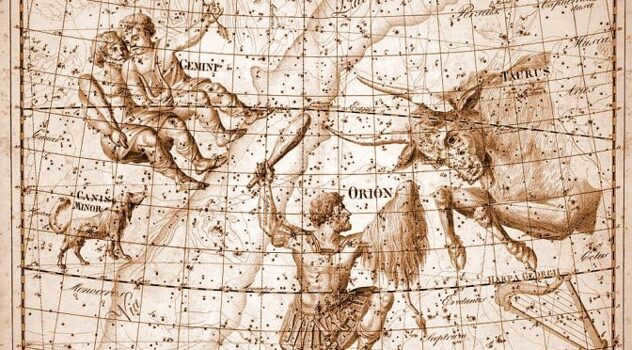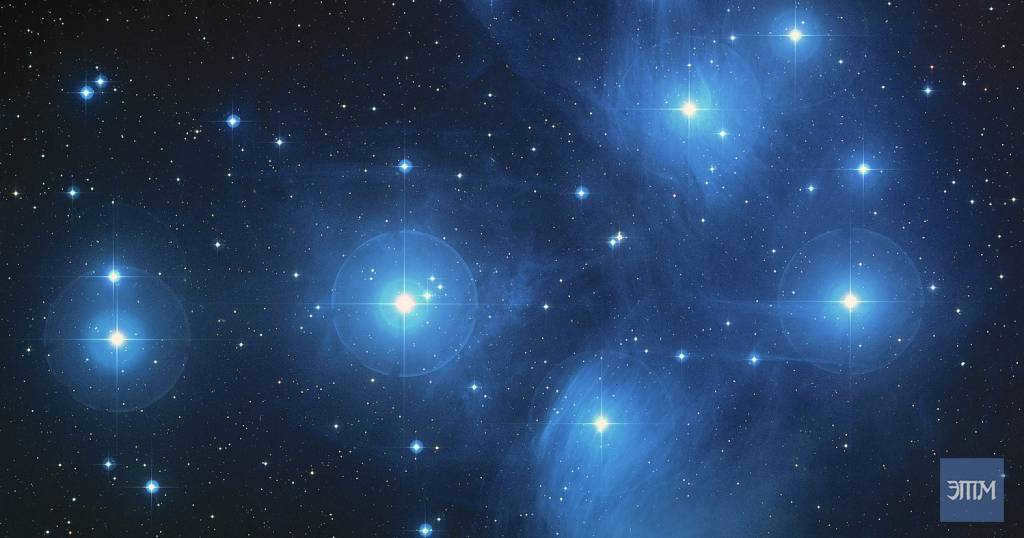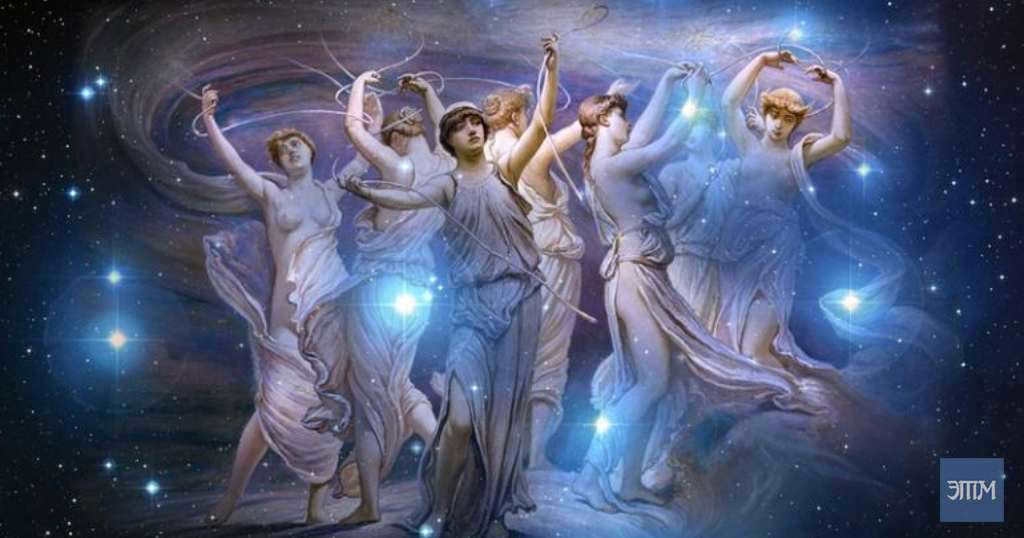Constellations were observed by people in ancient times, and each nation had its own unique names for them, which often differed from the names used today. In Russia, for instance, the constellations were given Slavic names.


The Milky Way
All of its names in Old Russian and Old Slavic were also linked to the idea of a path or road: “Bird’s Path”, “Goose Road”, “Duck Road”, “Straw Road”, “Stanovishche”.
Since the position of the Milky Way in the sky changes every month, it was used to determine the cardinal directions. It is sometimes referred to as “The Road of Spirits”, a mystical name associated by historians with Slavic beliefs that the soul ascends to heaven after death and becomes a star, finding a place in the Milky Way.
The Constellations of Ursa Major and Ursa Minor
The Ursa Major constellation, also known as the Big Dipper, is most visible in March, which marked the beginning of the new year according to ancient calendars. It served as a key point of reference for the Slavic people residing in the Northern Hemisphere, enabling them to determine the cardinal directions throughout the year.
In the Russian tradition, this constellation was referred to as “Big Kovsh”, “Elk”, “Sohatiy”, “Voz”, “Cart”, “Wagon”, “Plow”, and “Horse at rest”.
Some theories suggest that the names “moose” were adopted from the neighboring Finno-Ugric peoples, who were skilled hunters and utilized moose as their riding animals. Additionally, the term “cart” may have been borrowed from the ancient Germans, who shared a common ancestry with the Finno-Ugrians during the 1st and 2nd millennia BC.
The Little Dipper, also known as the “Little Ladle” or “Moose”, had alternative names in ancient times.
Polaris (constellation of the Little Dipper)
In ancient times, our ancestors referred to Polaris as the “Kol” or “Nail”. The Slavs visualized it as a stake around which the stars revolve (similar beliefs can be found in other cultures). This is not surprising, considering that Polaris is located at the North Pole.
Orion
Russian Slavs held a particular fascination for the trio of stars at the core of Orion, known as the “Belt of Orion.” In Russia, these stars were referred to as the “Three Plows,” “Rake,” and “Kosari,” names that clearly reflected their association with agricultural labor. It is worth noting that the constellation would rise at the conclusion of summer, a time when people would venture out in the early morning to embark on their mowing duties.
Taurus
The name “Yunets” was also given to this constellation by our Slavic ancestors, but the current name has been used in Russia. Scholars speculate that it acquired its name in ancient times, when our ancestors were primarily engaged in raising cattle, and the vernal equinox was positioned within this particular constellation.
This cluster of stars, which is also situated in the Taurus constellation, was highly esteemed by our ancestors. They referred to it by different names such as “Seven Sisters,” “Hair,” “Stozhary,” and “Volosozhary.” The Pleiades have a unique characteristic – they can only be observed in the sky from August to April in the central region of Russia.
Historians suggest that the movement of the Pleiades in the Russian sky might have been connected to economic activities, such as the timing of harvests.
There may have been various names associated with the deity of cattle breeding Veles, who is similar to the Greek god Hermes, the son of Maya, one of the Pleiades. The term “Stozhary” is derived from the word “stog”. Among the Eastern Slavs, a stozhar referred to a stake that was inserted into the ground to reinforce a haystack.
The Russian name for this constellation is “Yarem” (“yarmo”). In astrology, this sign is connected with commerce. Additionally, the Sun enters the sign of Libra following the autumnal equinox, which traditionally marked the beginning of fairs, the collection of tribute, and the payment of taxes in Russia.
Aquarius
The constellation Aquarius is known by various names in Russian and Slavic texts, such as “Mokreshya,” “Vodolyatel,” and “Vodotochtets,” which are similar to its current name.
In the southern part of the horizon, this constellation can only be observed, and in the middle latitudes, it becomes invisible by early November. It is during this time that the Slavs celebrated festivals in honor of the goddess of crafts, Makosh (Mokosh). Aquarius becomes visible again in the spring, coinciding with the “wet” season of melting snow and flowing streams.

The Pleiades, an illustrious star cluster, creates one of the most identifiable objects in the nocturnal heavens. Recognized by ancient civilizations across the globe for its conspicuous presence, it also held the moniker “Seven Sisters.”
Virtually every society throughout history has woven numerous legends and myths around this celestial cluster. The tales of the Seven Sisters have been transmitted from one generation to the next through oral tradition, artistic expression, poetry, architectural motifs, and musical compositions. Indians, Persians, Egyptians, Chinese, Greeks, Aborigines, and Native Americans each incorporated their unique variations of this story into their respective mythologies.
The Pleiades, a star cluster known to the Chinese for over 4,000 years and referred to as “Subaru” in Japan, has an interesting contradiction. Strangely enough, this contradiction is most evident in the emblem of the car manufacturer that bears the same name as the cluster.
The car brand Subaru’s logo features six stars, representing the Pleiades. However, when you observe the night sky, you will also notice only six stars in the actual cluster, not seven.
This raises the question of why various cultures, unrelated and geographically distant, have claimed that the Pleiades consists of seven stars. Where, then, is the elusive seventh sister situated?
Well-known in ancient times.
The Pleiades, along with the constellation of Orion that follows them across the sky, were mentioned in the earliest writings of ancient civilizations. These stars were recorded in Chinese chronicles as early as 2350 BC, and the oldest surviving mention in literature can be found in a poem by Hesiod written around 700 BC.
Sailors navigating the vast seas relied on the stars, particularly those that were familiar and easily recognizable. Farmers used the Pleiades to determine the optimal time for sowing seeds and harvesting their crops. The Zuni people, who reside in western New Mexico today, have referred to them as “seed stars” since ancient times.
From ancient Greek mythology, we have the knowledge of the names of all seven sisters of the Pleiades, who were the daughters of Atlanteus and Pleione. This provides us with the initial clue to unraveling the enigma. So, the names of the sisters were Maia, Alcyone, Merope, Asterope, Keleno (Celeno), Taygeta, and Electra.
The eldest sister, Maia, stands out due to her exceptional beauty and her preference for a secluded life. Alcyone, the second sister, held great significance as she was responsible for safeguarding the Mediterranean Sea, ensuring its safety and tranquility for sailors.
Asterope, whose name translates to “star-faced,” is often portrayed as one of the more delicate sisters. Keleno derives her name from her swarthiness and, like Asterope, does not shine as brightly as the others.
Tayget, also known as “Tiggy” in the myths, shares a similar desire for independence as Maia and resided in the mountains. Electra stands as the third brightest star among the sisters.
All of these celestial bodies are still observable in the sky today. However, there is one star, known as the seventh star or Merope, that cannot be found. It is often referred to as the “lost Pleiades” because it was the final star to be identified by ancient astronomers. Despite its classification as the faintest star in the cluster, it was still discernible to the naked eye.
The presence of Merope in the Pleiades constellation is initially perplexing. There are numerous other stars in close proximity to the Pleiades that are not included in the constellation, despite their clear visibility. Therefore, the inclusion of Merope alongside its brighter counterparts appears rather peculiar.

One possible explanation for this question can be found in Greek mythology. She was the daughter of Atlanteus, a titan in Greek mythology who carried the sky on his shoulders. Merope, unlike her sisters who married gods, decided to marry a mortal, which brought shame to her family and the Pleiades.
Her marriage to the earthly king Sisyphus caused her to hide in the night sky, where she became barely visible. This union was considered insignificant and she was punished by being made less prominent in the sky.
Another myth involves Sisyphus, who was punished by the gods for betraying Zeus and trapping Thanatos, the Greek god of death. As a result, Sisyphus was condemned to an eternity of rolling a boulder uphill in the Greek underworld.
Merope embarked on a journey alongside her husband who was cursed, venturing into the depths of the underworld. Her unwavering determination led her to remain by his side even after their deaths. The obscurity of Hades enveloped her, causing her to gradually fade into the expanse of the nocturnal sky.
An Enigmatic Figure in Various Cultures
A multitude of cultures across the globe have documented narratives akin to the tale of the Lost Pleiades. Indonesian, Native American, African, European, and Australian societies each possess their own accounts pertaining to the seventh sister and the reasons behind her diminished luminosity.
Nevertheless, this enigma proves to be far from straightforward, as there appears to be an underlying mystery at play. The prevalence of the invisible seventh sister mentioned in countless legends spanning different civilizations defies easy comprehension. Could there be an undisclosed connection between these disparate societies that could elucidate the presence of the concealed seventh sister?
The Dance of the Seven Sisters
There exists an alternative, more plausible explanation. The seven sisters, similar to the entirety of the nocturnal sky, are not stationary: they are engaged in an eternal celestial dance with one another, graceful and unhurried.
Contemporary astronomical observations have provided scientists with the means to reconstruct the chronicles of this dance spanning the last 100,000 years. Their findings were as anticipated: the stars were in motion relative to one another and our planet, resulting in their appearance differing from what was observed by ancient civilizations.
This alteration, combined with a night sky devoid of the light contamination characteristic of present-day society, may have enabled ancient skywatchers to distinguish the seven stars of the cluster, including Merope, which is now imperceptible.
Therefore, it is probable that she was more discernible in previous centuries than she presently is.





